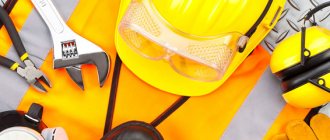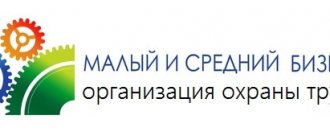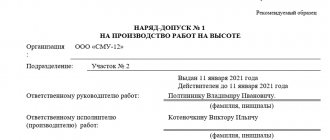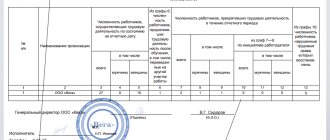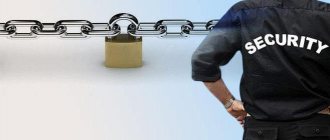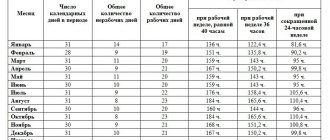What is a special assessment
This is a whole complex of actions. It includes an analysis of workplaces for the presence of factors that negatively affect human health and the level of their deviation from the norm. The algorithm for conducting SOUT is established at the legislative level - in Federal Law No. 426-FZ dated December 28, 2013 and Order of the Ministry of Labor of Russia dated January 24, 2014 No. 33n. The law defines not only the concept, the frequency of special assessments of working conditions for various organizations and the methodology, but also how long the SOUT is valid.
Assessment activities are carried out by specialized organizations for the purposes of:
- determining the presence of harmful or health-hazardous factors that lead to illness or injury to an employee (Article 209 of the Labor Code of the Russian Federation);
- assessing the level of influence of harmful factors on employees;
- determining the degree of deviation from normal indicators;
- determining the effectiveness of PPE and collective protective equipment used at the enterprise.
The Labor Code of the Russian Federation and Law No. 426-FZ of December 28, 2013 determine the mandatory implementation of special labor conditions by all employers, as well as how many years a special assessment of working conditions is valid.
An additional incentive for the employer to evaluate jobs is the possibility of reimbursement of part of the expenses incurred from the Social Insurance Fund (Order of the Ministry of Labor dated December 10, 2012 No. 580n).
How the legislation on SOUT has changed until 2021
At first, special assessment activities were called “Workplace Certification”, then they were renamed SOUT (special assessment of working conditions). Since 2014, the main nuances of this procedure are regulated by the Law of December 28, 2013 No. 426-FZ “On the special assessment of working conditions.”
Since then, this law has been amended 5 times: by the laws of June 23, 2014 No. 160-FZ, of July 13, 2015 No. 216-FZ, of May 1, 2016 No. 136-FZ, of July 19, 2018 No. 208-FZ and of December 27, 2018 No. 553-FZ.
Despite the fact that the procedure for conducting special assessments has already been studied and has been used in practice for several years, the legislation on special assessment continues to be adjusted. The purpose of the amendments is to improve the quality of special assessments in order to ensure guarantees and rights of workers.
Now another package of amendments to Law No. 426-FZ is approaching ─ draft No. 769142-7 is already in the State Duma. The start of application of the new version of the law is scheduled for January 2021.
Why carry out
The special assessment is aimed at determining the classes of working conditions at a specific workplace (Part 2, Article 3 426-FZ):
- optimal;
- acceptable;
- harmful;
- dangerous.
The assigned class depends on:
- the rate of insurance contributions that the employer pays to the Pension Fund for the benefit of employees: the better the situation, the lower the contribution;
- guarantees and compensation provided to employees in harmful or dangerous working conditions (additional allowance - Article 117 of the Labor Code of the Russian Federation, reduction of the working day - Article 92 of the Labor Code of the Russian Federation, increase in wages - Article 147 of the Labor Code of the Russian Federation).
The better the quality of jobs, the lower the employer's costs.
IMPORTANT!
The validity period of the SOUT in the organization is 5 years.
How are working conditions classified when hazardous conditions are identified?
If harmful factors are identified during the SOUT, namely: exceeding the maximum permissible concentrations or levels. In this case, hazard classes 3 and 4 are established.
If the maximum permissible concentration of harmful substances is exceeded, the workplace is assigned class 3 or 4
Class 3 means that the working conditions are harmful, and is divided into 4 classes, that is, 3.1; 3.2; 3.3; 3.4. These classes are established depending on the number of times the indicators exceed the permissible level. The factor of the technological process is also considered, namely: is it possible to carry out the appropriate measures in order to achieve optimal working conditions.
Based on these indicators, the percentage of additional payments in the appropriate conditions is determined.
Class 4 is established if the results of the analyzes exceed the permissible limits and it is impossible to work with such indicators at a given place, after which the place is liquidated if it is impossible to carry out any measures to improve working conditions.
When to carry out
The deadline for carrying out special assessments by law is no more than 12 months from the day when a new workplace is created, that is, the timing for conducting special assessments at new workplaces is no later than one year from the date of their appearance. If the enterprise was created more than 12 months ago and a special assessment has not been carried out at all, measures must be initiated immediately.
It is advisable to adhere to the algorithm in which SOUTH must be carried out at the new place of work no later than six months from the moment of its creation. This position is supported by Article 17 426-FZ and Article 212 of the Labor Code of the Russian Federation, according to which the employer is obliged to conduct a special assessment. He needs:
- create a safe environment;
- ensure labor protection for workers;
- provide employees with information about the degree of harmful influence of working conditions on them.
At the same time, an employee under Art. 219 of the Labor Code of the Russian Federation has the right to demand:
- availability of safe working conditions;
- providing information about the level of harm caused to his health at the place of work.
If the company does not provide the employee with the necessary information, the employer will then break the law.
IMPORTANT!
Please pay attention to the peculiarity of conducting SOUT in places that are vacant. The Ministry of Labor of the Russian Federation in Letter No. 15-1/OOG-1041 dated March 14, 2016 explains that assessments should not be carried out at such places. A special assessment of working conditions is carried out during production processes. But since the employee is not at the place of work, the process is not carried out. As a result, an unscheduled SOUT for a vacant place can be carried out only after the appointment of an employee and the start of his work activity in a specific place.
SOUT: frequency and timing
When starting its activities, a new organization sometimes does not even suspect what activities it will need to carry out - even if they are of a purely formal nature. Any enterprise in Russia is required by law to undergo the SOUT procedure. The period for the first time (for new organizations) is no more than six months. That is, after registering a company, the employer must conduct an inspection of working conditions in the first 6 months of its work. If an enterprise has existed for more than six months, and an inspection has never been carried out since its formation, then this must be done as quickly as possible, or better, as they say, yesterday.
The results of the special assessment are valid for 5 years from the date of issuance of the report based on the results of the audit.
Carrying out special labor conditions in the workplace, according to the Labor Code of the Russian Federation, is explained by the fact that the employer undertakes to ensure:
- safety and health of workers;
- informing employees about the conditions under which they work, etc.
It also follows from Article 219 of the Labor Code that employees can count on:
- safety and security of the conditions in which they work;
- informing about the danger/harmfulness of these conditions.
When hiring a job, a person has every right to demand from his employer information about the level of risk and potential (or actual) harmful factors in the work process. Even if it concerns the banal presence of a computer screen.
If the employer ignores this right and does not disclose information to the hired employee, the employee can contact the state supervisory authority. The very fact of such treatment already means for the employer a fine of 80 thousand rubles and a requirement for an urgent special assessment of working conditions. If the state supervision order remains unheeded, the organization faces suspension of activities for up to 90 calendar days.
SOUT results: what to do with the test results?
Based on the assessment results, harmful factors can be:
- Not detected at all.
In this case, the workplace can be declared to the Labor Inspectorate. Since the working conditions at this place comply with labor safety standards, it means that there is no need to inspect this place in the future. If the employer does not reorganize the workplace in the next 5 years, then he will not need an unscheduled SOUT. The declaration will be automatically renewed. - installed and classified in the required manner.
Then the validity period of the SOUT is 5 years. But the law does not allow interruptions in inspections. Therefore, after five years, the employer must already have the results of the mandatory automated workplace (certification). Certification of a workplace is, in its meaning, the same procedure as SOUT, only under a different name. If the employer carried out an automated work procedure no later than January 1, 2014, then he is allowed not to do any checks until the expiration of the certification.
How often should SOUT be carried out in an institution?
The validity period begins from the date when the report on a special assessment of working conditions at a specific place of work is approved. The answer to the question of how many years the SOUT is valid depends on risk factors. There are two options.
| Risk factors not established | The place of work should be declared to the local employment service agency of the subject in connection with the compliance of the conditions with established labor safety standards. The declaration is drawn up and submitted in accordance with the requirements of 426-FZ. Providing the document is the employer's responsibility. The form and submission algorithm are established by Order of the Ministry of Labor of the Russian Federation dated 02/07/2014 No. 80n, and explanations for its completion are in the Letter of the Ministry of Labor of the Russian Federation dated 06/23/2014 No. 15-1/B-724. Over the next 5 years, the employer can:
|
| Risk factors are identified and assigned to a specific class | The validity period of a special assessment of working conditions at workplaces is 5 years. By the end of this period, the organization must have ready-made results, that is, interruption of the operation of the SOUT is not provided. |
If no harmful factors are detected
When conducting a special assessment, experts do not in all cases identify the presence of harmful production factors. For example, when measuring dust or gas contamination, all indicators are set to normal. It turns out that everything is within acceptable limits and the employee can work calmly without fear for his life and health.
If no harmful factors are detected, then the workplace belongs to class 1 or 2, and is then declared. The first hazard class means that the working conditions are optimal, and the second class means that they are acceptable.
It turns out that there is no point in carrying out further work on the special assessment. The declaration is issued together with certification cards and indicates that there is no danger in the workplace.
Timing of unscheduled SOUT
For an unscheduled special assessment of working conditions, the time frame depends on the reasons and is 6 or 12 months.
| Term | Conditions for conducting an unscheduled SOUT |
| 6 months |
|
| 12 months |
|
Timing of activities based on the results of the SOUT
From the moment the report with the results of a special assessment of working conditions is approved, the employer must:
- no later than 3 working days, send a notification of the actual approval of the report to the special organization that conducted the assessment;
- no later than 30 calendar days, familiarize employees with the results of the special operational assessment in writing;
- no later than 30 calendar days, post on the employer’s website (if available) information on the results and a list of measures aimed at improving working conditions.
Distribution of PPE and milk
Standards for the provision of personal protective equipment, washing and neutralizing agents, milk and other equivalent food products, therapeutic and preventive nutrition: Point 426 at the place of preparation and approval Constantly in other organizations 3 years after replacement with new ones Documents (memos, acts, conclusions, correspondence) on providing workers and employees with personal protective equipment, flushing and disinfectants, milk and other equivalent food products, therapeutic and preventive nutrition 3 yearsIn the absence of other documents on harmful and dangerous working conditions, acts and conclusions - 75 years if completed before January 1, 2003, 50 years - if after January 1, 2003
Paragraph 427 Lists (statements) for the issuance of personal protective equipment, flushing and neutralizing agents, milk and other equivalent food products, therapeutic and preventive nutrition 1 year Paragraph 428How long to store materials and documentation on SOUT
The duration of storage of the results of a special assessment of working conditions depends on the type of material that needs to be stored.
| Document type | Shelf life |
| Report | It is determined by order of the employer in the process of organizing the SOUT during the formation of the composition of the commission. |
| Materials |
|
Body check
Lists of harmful, hazardous production factors and work, during which mandatory preliminary and periodic medical examinations (examinations) are carried out: Point 411 at the place of development and approval Constantly in other organizations Until replaced by new ones Documents (procedures, recommendations, psychophysiological requirements) on diagnostics (examination ) professional suitability of employees: Clause 412 at the place of approval Continuously in other organizations Until replacement with new ones Protocols, conclusions of psychophysiological examinations of workers 5 years if completed with office work before January 1, 2003, 50 years - if after January 1, 2003 Clause 413Responsibility
Failure to comply with the legislator's requirements regarding the assessment methodology (for example, violation of deadlines, errors in generating a report, etc.) will result in punishment under Art. 5.27.1 Code of Administrative Offenses of the Russian Federation:
- for an official - up to 10,000 rubles;
- for a legal entity - up to 80,000 rubles.
Repeated violations will increase the amount of fines:
- for an official - up to 40,000 rubles (or disqualification for up to 3 years);
- for a legal entity - up to 200,000 rubles (or suspension of activities for up to 90 days);
- for individual entrepreneurs - up to 40,000 rubles (or suspension of activities for up to 90 days).
